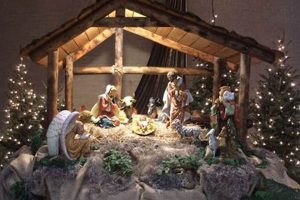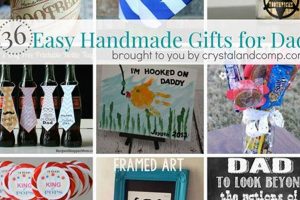A self-constructed holiday entrance adornment, typically fashioned from materials such as evergreen boughs, lights, and decorative ornaments, defines a festive gateway. An example includes a frame built from PVC pipe covered in faux garland and embellished with baubles and a star.
The creation of personalized Yuletide decorations provides cost savings compared to purchasing pre-made items and allows for customization reflecting individual preferences. Historically, using natural elements in winter decorations stems from pagan traditions symbolizing continued life and hope during the darkest months.
The following sections will outline material selection, construction techniques, and design considerations for crafting a unique and visually appealing holiday display. Detailed instructions and inspirational ideas will also be presented.
Essential Considerations for Holiday Gateway Construction
This section provides crucial guidelines for constructing a festive entryway, ensuring both aesthetic appeal and structural integrity. Attention to detail is paramount for a successful project.
Tip 1: Frame Selection: Choose a robust frame material, such as metal conduit or pressure-treated lumber, capable of withstanding environmental conditions. Consider the overall weight of decorative elements when selecting material and constructing the foundational support.
Tip 2: Secure Attachment: Utilize appropriate fasteners, such as heavy-duty staples or zip ties, to firmly attach foliage and decorations to the frame. Inadequate attachment can lead to sagging or detachment, compromising the visual impact and potentially creating a safety hazard.
Tip 3: Electrical Safety: Employ only outdoor-rated electrical lights and extension cords. Ensure all connections are weatherproofed and protected from moisture to prevent electrical shorts or hazards. Ground Fault Circuit Interrupter (GFCI) outlets are highly recommended.
Tip 4: Material Durability: Select weather-resistant materials, such as artificial foliage and UV-protected ornaments, to maintain visual appeal throughout the holiday season. Natural foliage may require regular replacement to prevent browning and shedding.
Tip 5: Weight Distribution: Distribute decorative elements evenly across the structure to maintain balance and prevent stress on specific areas. Uneven weight distribution can lead to structural instability and potential collapse.
Tip 6: Secure Mounting: Securely anchor the structure to the ground or supporting posts using appropriate hardware, such as stakes or brackets. This is crucial for preventing tipping or displacement due to wind or other external forces.
Tip 7: Strategic Placement: Position the structure in a location that maximizes visual impact without obstructing pathways or creating safety hazards. Consider the viewing angle and surrounding landscape when determining placement.
Implementing these guidelines ensures a safe, visually appealing, and long-lasting festive entryway. Careful planning and execution are essential for a successful outcome.
The subsequent sections will delve into specific design styles and advanced construction techniques for creating a truly unique holiday display.
1. Frame Stability
Frame stability constitutes a foundational element in the successful creation of a self-assembled holiday gateway. It directly influences the structure’s ability to withstand external forces and maintain its aesthetic form throughout the seasonal display period. Without adequate stability, the entire endeavor is at risk of collapse or significant deformation, rendering the project ineffective and potentially hazardous.
- Material Selection and Load Capacity
The choice of materials directly determines the frame’s ability to bear the weight of decorations, lighting, and foliage. Using lightweight materials, such as thin-walled PVC, may be insufficient for larger structures or those with heavy ornamentation. Conversely, robust materials like steel conduit or treated lumber offer superior load-bearing capabilities. The selection must align with the anticipated weight to prevent sagging, bending, or complete structural failure. Consider calculating total load and consulting material specifications.
- Joint Construction and Reinforcement
The points where frame members connect are inherently weaker than the members themselves. The type of joint employed and its method of reinforcement are critical for overall stability. Weak joints, such as those relying solely on adhesive, are prone to failure under stress. Utilizing mechanical fasteners (screws, bolts), bracing elements (gussets, corner brackets), or welding techniques enhances joint strength. Careful attention to joint detail prevents premature degradation and maintains the integrity of the entire structure.
- Anchoring and Ground Resistance
A stable frame must be securely anchored to the ground or supporting surface to resist wind loads and accidental impacts. Inadequate anchoring can result in tipping or displacement, particularly in exposed locations. Employing stakes, anchors, or weighted bases provides resistance to external forces. The choice of anchoring method should be appropriate for the surface (soil, concrete) and the expected wind conditions. Deeper anchoring and wider base support enhance stability in windy climates.
- Environmental Factors and Degradation
Exposure to environmental elements, such as rain, snow, and temperature fluctuations, can compromise frame stability over time. Materials susceptible to corrosion, rot, or UV degradation will weaken and lose their structural integrity. Selecting weather-resistant materials and applying protective coatings (paint, sealant) extends the lifespan and maintains the stability of the frame. Regular inspection and maintenance are crucial for identifying and addressing potential issues before they escalate into significant structural problems. This can include tightening bolts and checking structural members.
The interplay of material properties, joint integrity, anchoring techniques, and environmental resilience determines the long-term performance of a holiday gateway. Neglecting any of these facets jeopardizes the structure’s stability and diminishes the overall success and safety of the project. Therefore, these considerations are not optional; they are inherent to a successful, visually appealing, and durable result.
2. Material Selection
The selection of materials constitutes a critical determinant in the success and longevity of a self-constructed holiday gateway. The inherent properties of the chosen materials directly impact the structural integrity, aesthetic appeal, and resistance to environmental factors. An ill-considered selection can lead to premature degradation, structural failure, or a diminished visual impact, thereby undermining the entire endeavor. For instance, using untreated wood in a humid climate invites rot and decay, compromising the frame’s stability. Conversely, employing weather-resistant PVC or powder-coated metal enhances durability and extends the lifespan of the structure. Similarly, the choice of decorative elementswhether natural foliage, artificial garlands, or ornamentsaffects the overall appearance and maintenance requirements. Natural materials necessitate regular replacement, while durable, weather-resistant artificial alternatives offer a longer-lasting, low-maintenance solution.
Beyond structural and aesthetic considerations, material selection also influences the safety aspects of the project. Electrical components, such as lights and extension cords, must be specifically rated for outdoor use to prevent electrical hazards. Using indoor-rated components exposes the project to the risk of short circuits, fire, and electrocution. Furthermore, the weight and stability of materials impact the ease of handling and installation. Heavy or unwieldy materials increase the risk of accidents during construction, while lightweight and manageable alternatives promote a safer and more efficient building process. The integration of lighting also needs to be planned considering if you’re going for string lighting or RGB strips to make the decorations glow. String lights can be bought at your local dollar store but aren’t as bright as LED strips that shine a rainbow.
In summary, informed material selection transcends mere aesthetic preference; it forms the bedrock of a structurally sound, visually appealing, and safe self-constructed holiday entrance. Careful consideration of material properties, environmental factors, safety regulations, and maintenance requirements ensures a successful and enduring display. Ignoring these factors results in a compromised project prone to failure, increased maintenance costs, and potential hazards. A durable and long-lasting self-assembled Yuletide adornment that reflects both skill and foresight requires material considerations.
3. Light integration
Illumination constitutes an indispensable element in the construction and presentation of a self-assembled holiday gateway. The strategic and effective incorporation of lighting not only enhances the visual appeal but also contributes to the overall ambiance and safety of the display. Neglecting the nuances of light integration diminishes the impact of the structure and potentially introduces safety concerns.
- Light Source Selection
The choice of light source directly influences the aesthetic effect and energy consumption of the holiday display. Incandescent lights, while traditionally employed, exhibit higher energy consumption and shorter lifespans compared to LED alternatives. LED lights offer greater energy efficiency, extended durability, and a wider range of color options, making them a preferable choice for modern constructions. Consideration should be given to the light’s color temperature (warm white, cool white, multi-color) to achieve the desired ambiance. For example, warm white LEDs create a cozy and inviting atmosphere, while cool white LEDs provide a brighter, more contemporary look. Further, the light source must be rated for outdoor use.
- Wiring and Power Considerations
Safe and reliable wiring is paramount for preventing electrical hazards. All wiring and connections must be weatherproofed and suitable for outdoor use. Employing Ground Fault Circuit Interrupter (GFCI) outlets provides an additional layer of safety, mitigating the risk of electrical shock. The power source must be adequate to support the chosen lighting configuration without overloading the circuit. Overloading can lead to overheating, tripped breakers, or even fire. Careful calculation of power requirements and adherence to electrical safety codes are essential. Low-voltage lighting systems offer an inherently safer alternative, reducing the risk of electrical hazards.
- Light Placement and Distribution
The strategic placement and distribution of lights determine the visual impact of the structure. Uniform lighting creates a consistent glow, while targeted lighting accentuates specific features or decorative elements. Careful consideration of light angles and intensity prevents glare or dark spots. For instance, uplighting can emphasize the structure’s height, while spotlights highlight individual ornaments. The arrangement of lights should complement the overall design and create a balanced and visually appealing effect. Consider spacing and directionality to avoid hot spots or uneven illumination.
- Control and Automation
Incorporating control and automation features enhances the convenience and versatility of the holiday display. Timers enable automatic activation and deactivation of lights, conserving energy and simplifying operation. Remote control capabilities allow for adjustments from a distance. Smart home integration enables control via smartphone or voice commands. These features offer increased flexibility and customization, allowing for dynamic lighting effects and automated scheduling. Programmable LED controllers permit the creation of complex lighting patterns and color sequences.
The successful integration of lighting transforms a simple self-constructed festive entrance into a captivating and enchanting spectacle. By carefully considering light source selection, wiring and power, light placement and distribution, and control and automation, a visually stunning and safe holiday display can be achieved. Neglecting any of these facets diminishes the overall impact and introduces potential hazards, undermining the entire endeavor.
4. Ornament Attachment
Secure and aesthetically pleasing ornament attachment is integral to the success of a self-assembled holiday gateway. The method by which ornaments are affixed directly impacts the structure’s visual appeal, structural integrity, and long-term durability. Inadequate or poorly executed attachment compromises the design and may lead to premature failure.
- Mechanical Fasteners and Load Distribution
The utilization of mechanical fasteners, such as hooks, wire, or zip ties, constitutes a primary method for ornament attachment. The selection of appropriate fasteners depends on the weight and size of the ornament. Insufficiently sized fasteners are prone to failure under load, resulting in ornament detachment and a degraded appearance. Careful consideration must be given to the load-bearing capacity of the frame and the distribution of weight to prevent localized stress and potential structural damage. For instance, a heavy ornament suspended from a weak point on the frame may cause bending or breakage. Distribution of weight, fastener strength, and structural integrity are critical to the ornament placement.
- Adhesive Solutions and Material Compatibility
Adhesive solutions, including glues and tapes, provide an alternative method for ornament attachment. However, the efficacy of adhesive methods hinges on material compatibility and environmental conditions. Certain adhesives may not bond effectively with specific materials, such as slick plastics or treated wood. Furthermore, exposure to moisture, temperature fluctuations, and UV radiation can degrade adhesive bonds over time, leading to ornament detachment. When employing adhesive methods, rigorous testing is advisable to ensure a secure and durable bond under anticipated environmental conditions. The correct application and use in accordance with the manufacturer will provide the best bond.
- Concealment and Aesthetic Integration
The method of ornament attachment should be implemented in a manner that minimizes visual intrusion and enhances the overall aesthetic coherence of the structure. Exposed fasteners or unsightly adhesive residue detract from the visual appeal of the display. Concealing fasteners with decorative elements or employing techniques that render them less visible contributes to a more refined and polished appearance. For example, using floral wire that matches the color of the foliage or strategically positioning ornaments to obscure fasteners. The overall structure will be greatly improved with hidden mechanical structures.
- Durability and Environmental Resistance
Ornament attachment must withstand the rigors of outdoor exposure, including wind, rain, and temperature fluctuations. Fasteners and adhesives that are susceptible to corrosion, degradation, or embrittlement compromise the longevity of the display. Selecting materials that are specifically designed for outdoor use and applying protective coatings mitigate the effects of environmental exposure. Regular inspection and maintenance are advisable to identify and address any signs of wear or degradation, ensuring the continued integrity and visual appeal. For instance, using stainless-steel fasteners and UV-resistant adhesives provides enhanced protection against the elements. Regularly assessing the fastener’s integrity will prevent future damage.
The method of ornament attachment is not merely a utilitarian consideration but rather an integral component of the overall design and functionality of a self-constructed holiday gateway. By carefully considering mechanical strength, material compatibility, aesthetic integration, and environmental resistance, a durable and visually appealing display can be achieved, enhancing the festive ambiance. A properly designed and applied attachment method will provide a durable, beautiful, and secure structure.
5. Weather Resistance
Weather resistance is a critical factor governing the longevity and aesthetic preservation of any self-assembled holiday gateway. External environmental factors, including precipitation, temperature fluctuations, and solar radiation, exert significant influence on the materials and structural integrity of such constructions. A failure to adequately address weather resistance results in accelerated degradation, diminished visual appeal, and potential structural compromise.
- Material Selection and Degradation
The inherent properties of the selected materials directly influence their susceptibility to weather-induced degradation. Organic materials, such as untreated wood or natural foliage, are prone to rot, decay, and insect infestation when exposed to moisture. Conversely, synthetic materials, such as PVC or polyethylene, exhibit greater resistance to moisture and biological degradation. UV radiation, a component of sunlight, can cause discoloration, embrittlement, and cracking in certain plastics and coatings. The selection of materials with inherent weather resistance or the application of protective coatings is essential for mitigating these effects. Consider the long-term effects of rain, sun, and snow on materials used.
- Fastener Corrosion and Structural Integrity
Fasteners, including screws, nails, and staples, play a crucial role in maintaining the structural integrity of the structure. However, exposure to moisture and corrosive elements can lead to fastener corrosion, weakening the joints and compromising the overall stability of the construction. Employing corrosion-resistant fasteners, such as stainless steel or galvanized steel, mitigates this risk. Furthermore, proper sealing of joints and fastener penetrations prevents water ingress and reduces the likelihood of corrosion. Regular inspection and replacement of corroded fasteners are advisable to ensure the long-term structural integrity. Use outdoor-grade fasteners.
- Finish Durability and Aesthetic Preservation
The application of protective finishes, such as paints, sealants, or varnishes, enhances the weather resistance and aesthetic appeal of the self-constructed entrance. These finishes provide a barrier against moisture penetration, UV radiation, and physical abrasion. However, the durability of these finishes varies depending on the type of product and the application method. Selecting high-quality, weather-resistant finishes and adhering to proper application techniques ensures long-lasting protection and aesthetic preservation. Regular cleaning and reapplication of finishes may be necessary to maintain their effectiveness. Select outdoor finishes for longevity.
- Design Considerations and Water Management
The design of the structure itself can influence its resistance to weather-related damage. Incorporating features that promote water runoff, such as sloping surfaces or drainage channels, minimizes the accumulation of moisture and reduces the risk of rot or corrosion. Adequate ventilation prevents the buildup of humidity and promotes drying. Designing the structure to withstand anticipated wind loads is also crucial for preventing damage during storms. Considerations of snow load are also important in regions subject to significant snowfall. Weather-conscious design will result in longevity.
The inherent connection between weather resistance and the successful deployment of a self-assembled festive entrance necessitates a comprehensive approach to material selection, construction techniques, and design considerations. By prioritizing weather resistance, the lifespan, aesthetic appeal, and structural integrity of the display can be significantly enhanced, ensuring a lasting and visually appealing holiday decoration.
6. Power Source
The successful illumination of a self-constructed holiday gateway hinges upon the selection and implementation of a suitable power source. The power source directly dictates the type and intensity of lighting that can be employed, impacting both the aesthetic effect and operational safety of the installation. A mismatch between the power source and the lighting demands results in either inadequate illumination or potential electrical hazards. For example, attempting to power a string of high-wattage incandescent bulbs with an undersized transformer leads to voltage drop, diminished brightness, and potential overheating. Conversely, utilizing a high-capacity power supply for a few low-power LED lights represents an inefficient and potentially hazardous configuration.
Consideration of power source also extends to the operational environment. Outdoor installations necessitate weather-resistant power supplies and wiring to prevent moisture ingress and corrosion. Battery-powered solutions offer flexibility in placement but require periodic replacement or recharging. Solar-powered options provide sustainable and cost-effective illumination in suitable locations, but their performance is contingent upon sunlight availability. A real-world example would be using a solar panel with a rechargeable battery to power LED strip lights woven into evergreen garlands, offering wireless operation and reduced energy consumption. Moreover, the power source should be properly grounded and protected by a Ground Fault Circuit Interrupter (GFCI) to mitigate the risk of electrical shock, ensuring a safe holiday display for viewers.
In summary, the power source functions as an indispensable component in the realization of an illuminated holiday entrance. Its selection requires careful evaluation of lighting requirements, environmental conditions, and safety considerations. A well-chosen and properly installed power source ensures consistent, safe, and aesthetically pleasing illumination, enhancing the visual impact of the self-constructed Yuletide display. This essential decision is required for a successful build. Neglecting power source requirements is a fundamental flaw.
7. Overall Design
Overall design serves as the unifying framework for a successful self-constructed holiday gateway. It dictates the visual coherence, structural integrity, and functional effectiveness of the final product. A well-conceived design integrates material selection, light integration, ornament attachment, weather resistance, and power source considerations into a harmonious and aesthetically pleasing whole. Without a cohesive design strategy, the resulting structure risks appearing disjointed, unstable, or functionally inadequate. For example, a design that incorporates heavy ornaments without considering frame strength results in a structurally unsound display. Similarly, a lack of integration between lighting and decorative elements can lead to a visually unappealing or underwhelming outcome.
Effective design extends beyond mere aesthetics, encompassing practical considerations such as ease of construction, maintainability, and safety. A design that is overly complex or utilizes unconventional materials may prove difficult to execute or maintain over time. Incorporating modular components or simplified construction techniques enhances the ease of assembly and repair. Safety considerations, such as secure anchoring and weather-resistant electrical connections, are integral to a well-designed holiday entrance. For instance, a design that includes readily accessible electrical components without proper weatherproofing poses a significant safety hazard. A practical application includes creating a detailed schematic drawing that encompasses all elements, including dimensions, materials, and electrical wiring diagrams, before commencing construction.
In conclusion, the overall design functions as the linchpin of a successful self-assembled festive gateway. It provides the strategic framework for integrating diverse components into a unified and functional whole. While creativity and personal expression are integral to the construction process, adherence to sound design principles is essential for ensuring structural integrity, aesthetic appeal, and operational safety. Overcoming design challenges requires a thorough understanding of material properties, construction techniques, and environmental factors. The comprehensive design consideration is vital to the process.
Frequently Asked Questions
This section addresses common inquiries regarding the planning, construction, and maintenance of a self-assembled holiday gateway. The following questions and answers provide guidance on essential aspects of this project.
Question 1: What is the appropriate material for constructing the frame?
Frame material selection depends on the desired size, weight, and aesthetic. Pressure-treated lumber provides robust support for larger structures, while metal conduit offers a lighter and more versatile alternative. PVC pipe presents a cost-effective option for smaller, less demanding installations.
Question 2: How can illumination be safely integrated into the structure?
Outdoor-rated lighting, including LED string lights or projection systems, should be utilized. Weatherproof connections and Ground Fault Circuit Interrupter (GFCI) outlets are essential for preventing electrical hazards. Wiring should be concealed and protected from physical damage.
Question 3: What methods are recommended for securing ornaments?
Durable mechanical fasteners, such as hooks, wire, or zip ties, provide a secure means of attaching ornaments. Adhesive solutions may be appropriate for lightweight decorations, provided the adhesive is compatible with the materials and resistant to weather exposure.
Question 4: How can the display be protected from inclement weather?
Employ weather-resistant materials, such as treated lumber, PVC, or powder-coated metal. Apply protective finishes, such as paints or sealants, to prevent moisture damage. Ensure adequate drainage to prevent water accumulation.
Question 5: What are the key safety considerations during construction?
Wear appropriate personal protective equipment, including safety glasses and gloves. Use caution when working with power tools. Ensure the structure is securely anchored to prevent tipping or collapse. Employ a GFCI outlet for all electrical connections.
Question 6: How can the display be maintained throughout the holiday season?
Regularly inspect the structure for any signs of damage or wear. Tighten loose fasteners and replace damaged components as needed. Remove snow or ice accumulation to prevent overloading. Monitor electrical connections for any signs of corrosion or damage.
These FAQs provide fundamental guidance for the creation of a safe, durable, and visually appealing holiday gateway. Adherence to these recommendations enhances the likelihood of a successful and enjoyable holiday display.
The subsequent sections will offer advanced tips and techniques for elevating the aesthetic impact of the self-assembled structure.
DIY Christmas Arch
The preceding discussion has outlined key considerations for creating a self-constructed holiday entrance. Structural integrity, material selection, light integration, ornament attachment, weather resistance, power source implementation, and overall design all contribute to a successful project. These elements must be meticulously addressed to ensure safety, durability, and visual appeal.
The construction of a “diy christmas arch” represents a significant undertaking requiring careful planning and execution. A well-executed project enhances the festive atmosphere and offers a personalized expression of holiday spirit. Continued adherence to safety guidelines and maintenance practices will ensure the enduring enjoyment of this seasonal display.







